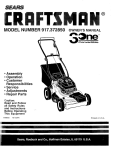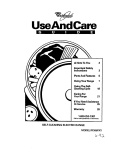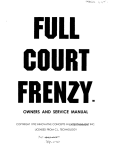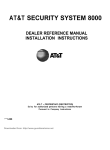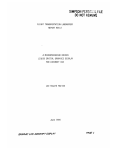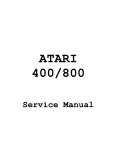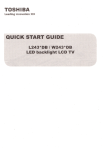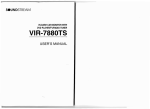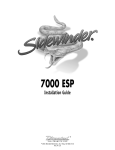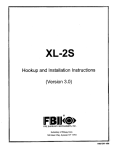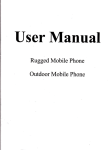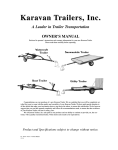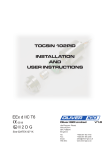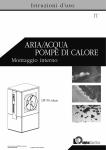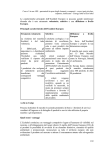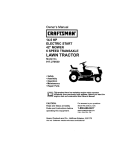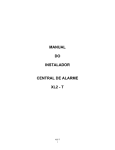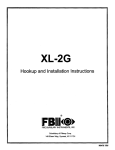Download Model XL-2FZ Hook-up and Installation Instructions
Transcript
XL-2FZ Hookup and llnstallation l’nstructions FIRE BURGLARY INSTRUMENTS; INC. A Subsidiary of Pittway Corp. 163 Eileen Way,Syosset,NY 11791 (800) 645-5430 (516) 921-8666 l N9244 393 07 992, FBX / 1. INTRODUCTION 2 The XL2FZ series is a state of the art EEPROM based control/communicator, The system features six fully prograrhnab~~i zones each capable of fast loop zone response, as well as a wired panic zone (or keyswitch zone). Programming can& performed through the keypad or the system can be uploaded and downloaded remotely using the EZ-Mate PC DownloadeL In addition, remote control actions can be taken. The system contains up to six user codes with capability for ambush code- ’ and an arm only code. All of the keypads are four wire devices, with up to four keypads per system. The system can be used with the following keypads: XL4600RM Flush Mount LED Metal Plate Keypad XL4600SM Surface Mount LED keypad 6615 Surface or recessed mounted LED based keypad 6605 Surface or recessed mounted LCD based keypad . XLBFZ Hookup and Installation Manual Page 2 XL-2FZ TABLE OF CONTENTS lntroductlon ......................................................2 Table of Contents .............................................3 System Wlrlng and Hookup ............................4 Wiring Diagram ............................................. 4 Terminal Connections ................................... 5 PC Board Mounting.. .................................... .7 Keypad Mounting .............................................0 XL4600RM Keypad’........................................ a XL 4600SM Keypads .................................... .9 6615/6805 Keypad Mounting ........................ .10 Keypad Layout .................................................11 System Operatlons ..........................................13 Power Up/System Reset ............................... 13 Arming ........................................................... 13 Stay Arming ................................................... 13 Instant Arming I.. ............................................ 13 Instant-Stay ................................................... 13 Disarming ...................................................... 14 Reset.. ............. .I ............................................ 14 Bypass ......................................................... .14 Auto-Unbypass .............................................. 14 Manual Unbypass ............................... ......... .14 User Code Programming .............................. 14 Duress/Ambush.. ........................................... 15 Arm Only Code.. .................................. ‘......... .15 User Deletion ............................................... .15 Keypad Emergency Conditions.. ...... . ........... .15 System ProgrammIng ......................................16 ProgrammIng Questlons .................................16 01 Primary Telephone Number.. .................. .16 02 Secondary Telephone Number ............... .16 03 Callback Number .................................... .16 04 Dialer Options .......................................... 17 05 Keypad Conditions ................................. .19 06 Account Number 1 .................................... 20 07 Account Number 2 .................................. .20 08 System Timeouts ..................................... 20 ZONE PROGRAMMING DESCRIPTION..........21 09 ZONE #l ................................................. 23 10ZONEM ..................................................23 11 ZONE #3 ................................................. .23 12 ZONE #4 .................................................. 24 13 ZONE #5 .................................................. 24 14 ZONE #6.. ............................................... .24 15 AMBUSH/AC LOSS.. .............................. .24 16 Panic/Low Battery ................................... .24 17 Open/Close, 24 Hr. Test ........................ .25 18 Bypass/Restore/Trouble/Tamper/# Rings 25 19 Keypad Fire/Keypad Aux ........................ .25 00 Installer Code ......................................... .25 Data Entry Vla LED Based Keypads.. .............26 How To Enter Programming Mode.. .................. .26 What You See On the Keypad.. ........................ .27 Ready LED ............................................... 27 Zone LEDS.. ............................................ .27 How To Enter Data ................................... 27 Movement Between Questions ............... .27 Movement Within Questions ................... .27 Data Entry ................................................ 28 How To Exit Programming Mode ...................... .28 Question Acknowledgment ..................... .29 Summary of System Programming.. ....... .29 Data Entry Through LCD Keypads ................... .30 How to Enter Programming Mode.. ......... .30 What You See On the Keypad.. ............... .30 How To Enter Data.. ................................ .30 Movement Between Questions ............... .30 Movement Within Questions ................... .30 Data Entry ................................................ 30 Exlt System Program Mode ...................... 30 Question Acknowledgment ..................... .30 Zone Descriptor Programming ............... .30 System Defaults ...............................................31 Llmltatlons Statement ......................................32 FCC STATEMENT.............................................33 XL-SF2 Programmlng Worksheet ...................34 Warranty ............................................................36 XLS-FZ Hookup and lnstallatlon Manual Page’3 3 \ SYSTEM WlRlNG AND HOOKUP l-. n 3.1. i SYSTEM WIRING DIAGRAM / WARNING, XL-2FZ To prevent risk from electricalshock, deenergizethe system control unit and disconnect the telephonelines before servicingthis unit. ZONE 2 -- -. / OEFAULT RESET: To reload factory -, delault values. remove all power from system (AC and DC). Next. short JPl to JP2. With short still intact. reapply power (AC then Oct. wall 5 seconds, then remove short with power still applied. .lPl -. Detail A ------------------ JP3 __ I CONTROL PANEL I cc I- 1 -Connect to a grounded metal cold water pipe (16 ga at 15 fact). 2 - Total AUX. Power available (including keypad powetj is SlOmA max . Us& for connectton of devices rated from 11 .O to 13.1 VDC. 3 - System must be tasted on a weakly basis. For information. rater to references. 4 - Do not comsct the tmnsformer to a switch controlled receptacle. Power varies with transformer (see Note 2). 5 - MaxImum of 4 keypads. Available keypads in&de XL4600RM. XL46WSM. 6615. 6805. 6 - Limited energy cable must be used. 7 - Non-replaceable fuse. Return unit to manufacturer if blown. Do not solder fuse in - field. 6 - For connection of VS-279 or VS-299 -cl R -i-1 l-2 Siren Driver. Constant positwe (+) Aux Power Bell Power unregulated output (lo-15SVDC) 1 Amp 3 Amps 9 - Elimination of fast zone response for any zone can be selected thmugh remova of the components as listed !=!I - n SED Banev 1 4 Amos l-l I BLACK II Al THlSFUSEN& 1 1 I 1 I I (15116) sw IOKE DETECTORi : t t-1 WARNING AUX POWER CONSTANT DC POWER I+) tARTH GROUND THIS UNIT INCLUDES AN ALARM VERIFICATION FEATURE THAT WILL RESULT IN A OELAY OF THE SYSTEM ALARM SIGuAL FROM THE INOICATEO CIPCUITS THE TOTAL DELAY (CONTROL UNIT PLUS SMOKE DETECTOR) %rALL NOT EXCEED 60 SECONDS NO FCC Registration Number AE396E-69564 AL-E Ringer Equivalence 0.08 References: Hwkuo and Installation lnsbuctions N9244 and Ownefs Manual N9121 01992PBX 3‘Y XL2-FZ Hookup and lnstallatlon Manual Page 4 2. TERMINAL CONNECTIONS TERMINALS 1(+)&2t-) a(+) & w / -- 4(+) & 5(-J et+) & W-1 7(+) & 6(-) 9(+) & 6 (-1 DESCRIPTION [Default [Default [Default [Default [Default [Default Zone 1 (Requires 2.2K EOL resistor) Zone 2 (Requires 2.2K EOL resistor) Zone 3 (Requires 2.2K EOL resistor) Zone 4 (Requires 2.2K EOL resistor) Zone 5 (Requires 2.2K EOL resistor) Zone 6 (Requires 2.2K EOL resistor) = DELAY = INTERIOR] = PERIMETER] = PERIMETER] = PERIMETER] = FIRE] ZONE INFORMATION Normally closed devices may be wired in series, normally open devices in parallel wfth the 2.2k ohm end of line resistor on all zones. The maximum loop resistance may not exceed 100 ohms. The loop response time is 6 - 10 ms on all zones zones containing normally closed devices only. Normal zone response can be obtained on any of the zones through removal of components from the PC board as follows: 3 4 c3 5 c5 6 C6 c4 NOTE: Removal of the component listed above will change the loop response of the zone to 280 mSec. The factory default values for each zone is listed in the table above, however any zone can be programmed for the following types: Delay, Perimeter, Interior, Fire, 24 Hr. Alarm, or 24 Hr. Trouble. Further explanation of the zone types can be found in the System Programming section of this manual. 6&10 PANIC CIRCUIT OR KEYSWITCH Normally open PANIC circuit. This hardwired panic is a 24 hour zone which can be programmed for silent or audible operation. The panic circuit will activate with each violation, therefore a latched device is recommended. If the keyswitch option is selected (see programming question 05) then each activation of the keyswitch will arm and disarm the system. NOTE: E.O.L. resistor is not required on this zone. 11 EARTH GROUND: Connect this grounding lug to a cold water pipe utilizing #lSAWG wire at a distance of no greater than 15 ft. If the premises pipes terminate in PVC, this terminal must be connected to a six(6) foot grounding rod. 12 13 14 15 KEYPADS: A maximum of 4.keypads, either XL4600RM, XL4600SM, 6615, or 6805, may be wired to these terminals. The connections are as follows; 12 (BLACK = negative), 13 (YELLOW = data in),14 (GREEN = data out) and 15 (RED = positive power). Each keypad draws approximately 30mA. Maximum keypad length is 500 feet using 22 gauge wire. 12 (-) & 15 (+) REGULATED POWER (11.5 - 13.1VDC) : The total regulatedoutput power for motiondetectors and other external devices is 500mA at 11.8 - 12.5V for residential applications, or 12.0 - 12.5V for commercial applications, with less than 100 mVPP ripple. 15(+) 16(-) SMOKE DETECTOR POWER: This system will accept 9.5 - 12VDC four(4) wire smoke detectors only. Approximately 5OmA of current is available at these terminals for powering all detectors and an E.O.L. relay FBI1 model 620. XLP-FZ Hookup and lnstallatlon Manual Page 5 These terminals adhere to the fire verification and reset logic which is explaln6 in the Zone types section of this manual. Manual reset of smoke detector powe can be accomplished by entering avalid usercode after clearing alarm memory; 17 16 19 20 TELEPHONE LINE: , \ Connect the model 388 cord as follows; 17 (GREEN = Telcd Tip), lB(RED =/ Telco Ring), lS(BROWN= Home Tip), 20(GREY= Hqme Ring). Insert the p&g‘ into an USOCRJ3lX jack (or a CA31A jack for Canadian installations). The FCC registration number is (AE398E-89554 AL-E), and the ringer equivalence is (O.OB).The system should not be connected to party lines, or win operated phones. 21 (+I Furthermore, this device should not be connected to a phone line which has call wafting, unless the call waiting interrupt numbers are programmed into the panel dialing sequence. CONSTANT DC POWER 22(+) &23(-) This terminal delivers constant unregulated 1O.O-15.5VDCpower for devices requiring a constant power such as VS279. It is connected to a bell fuse (F3). BELL OUTPUT: The total output power available for sounding devices is 1 amp at 10.5 - 15.5 VDC for residential applications. These terminals will deliver CONSTANT output on BURGLARY, AUDIBLE PANIC and BELLTEST. On a FIRE condltlon, a PULSED output will be generated. There are separate bell cutoff times programmable for Burglary and Fire conditions within the programming sequence. TRANSFORMER: 24 & 25 Connect the 12 VAC 20VA transformer, utilizing 18awg wire at a distance not to exceed 15 feet from the panel, to an unawltched 120 VAC outlet. Do not use any other transformer since this may result in improper operation or damage to the unit. rThe AC/LOW BAT LED on the keypad will remain 0N;while AC power is ‘j present. If an AC loss occurs the AC/LOW BAT LED will turn off immediately. If AC remains OFF for 15 minutes, the system will pulse the keypad buzzer and transmit to the central station, if programmed. THE KEYPAD BUZZER CAN BE SILENCED by entry of any valid user code. When AC restores the AC/LOW BAT LED will light immediately, and a restore code will be reported, if programmed. BACKUP BATTERY: GROUND START ‘The RED(+) and BLACK(-) flying leads must be connected to a 12 VDC 4-8AH GELL CELL, to serve as backup power in the event of AC loss. A battery test occurs approximately every 4.5 minutes. Low battery condition occurs at nominal IlVDC. The keypad AC/LOW BAT LED and buzzer will PULSE SLOWLY when low battery condition is detected. The system reports this condition to the CS if programmed. Battery restoral will occur WITHIN 4.5 minutes, at the NEXT battery test. THE BUZZER MAY BE SILENCED by entry of any valid user code. Ground start capability can be added to the system through addition of the FBI1 Model 117 fTIOdUl8. Consult the 117 Installation Instructions for hookup information. XLP-FZ Hookup and lnstallatlon Manual Page 6 3.3. PC BOARD MOUNTING PC BQard v Before mounting the printed circuit board, be certain that the appropriate metal knockouts have been removed. DO NOT A Al-TEMPT TO REMOVE THE KNOCKOUTS AFTER THE CIRCUIT BOARD HAS BEEN INSTALLED. 1. Hang the three mounting clips on the raised cabinet tabs. Observe proper clip orientation to avoid damage to the clip mounting screws are tightened and to avoid problems with insertion and removal of the PC board. 2. Insert the.top of the circuit board into the slots at the top of th8 cabinet. Make sure that the board rests in the slots as indicated in the diagram shown below. 3. Swing the base of the board onto the mounting clips. 4. Place the washer provided over the wire jumpers lOCat8d within the middle of the PC board. Secure the PC board to the middle mounting clip of th8 enclosure through the washer using the screw provided. 5. Secure the remaining sides of the PC board to the enclosure using th8 screws provided. When CLIP II~ISTALIATION A-CABINET Tag WITHOUT CLIP. B-CABINET TAB WITH HANGING CLIP DETAIL SIDE VIEW OF CLIP AND BOARD INSTALLED NOTE: The front face of the enclosure can be completely removed from the enclosure to gain unrestricted access to the control panel during installation. The front of th8 enclosure can be removed as follows: 1) Open th8 enclosure to its fully extended position (appnx 90 degrees) 2) Lll the control panel door and remove the door from the enclosure. XLZ-FZ Hookup and lnstallatlon Manual Page 7 . 4m KEYPAD MOUNTING 4.1. XL4600RM i’ i : METAL KEYPAD FLUSH MOUNTING USING DOUBLE GANG BOX 1~ Create an opening and mount a standard double gang box. 2- Secure keypad to double gang box, as shown in diagram below..Note: The double gang box should be mounted flush with the wall In order for the keypad screws to fit. FLUSH MOUNTINGWITH MOUNTING RING (Using the XL4600TR) I- Create the desired opening where keypad is to be mounted, using the inside of the mountrng ring as a template. NOTE: This opening should be made between studs. 2- Secure mounting plate to wall through the four outer holes using suitable mounting hardware (not provided). 3- Connect keypad wiring to control panel and secure the keypad to the mounting ring using the four painted screws provided. 3 SURFACE MOUNTING (Using optional XL4600RMBX) I- Depending on type of installation run the keypad wiring out of the rear, top bottom or sides of the backbox. 2- Attach backbox to wall at desired height 3- Insert XL4600RM keypad into backbox and secure with the four screws provided. MOUNTING KEYPAD IN CONTROL PANEL ENCLOSURE 1- Remove keypad knockout from front of metal box enclosure as shown. 2- Insert XL4600RM into opening from front of enclosure. 3- Secure keypad to enclosure using the four painted metal screws and nuts provided. XL20FZHookup and Installation Manual Page 6 l .2. XL4600SM . KEYPAD The XL4600SM Keypad may b8 surface mOUnt8d in the following ways: A. Directly to a control panel having a keypad cutout on the front of its enclosure. B. Directly to a single or double gang electrical junction box. C. Directly to a wall or other surface. , w 1. Remove th8 keypad cover aSS8mbly from the rear mounting plate. Insert a small screwdriver blade in the ‘COVER PRY-OFF SLOTS at the lower edge of the keypad (see Diagram 2 ) and twist to pry off the cover assembly. 2. Mount the rear plate (see Diagram 3). Note: The plate is correctly oriented when its part number, molded into the plastic, is upright. A. MOUNTING DIRECTLY TO CONTROL PANEL ENCLOSURE: If the control panel has a keypad cutout on the front I face of its enclosure, remove the cutout and mount the plate to th8 enclosure’s face via HOLES “A” ( se8 diagram 3) and the four screws and nuts provided. SLOT FOR [OPTIONAL) COVER SECURING SCREW. COVER PRY-OFF SLOTS (2) TO REMOVE COVER. INSERT SMALL SCREWDRIVER BLADE AND TWIST. Diagram 2: BOTTOM . VIEW OF KEYPAD B. MOUNTING DIRECTLY TO AN ELECTRICAL JUNCTION BOX: The plate can be mounted directly to a single or double gang electrical junction box. Use th8 screwholes provided and HOLES “B” for a single gang box or HOLES “A” for a double gang box. C. MOUNTING DIRECTLY TO A WALL OR OTHER SURFACE 11 N6054 II \ -J.” I I II POST FOR ,OPTtoNAL, -l COVERSECURINGSCREW. Diagram I II ELECTF’C* \ I I 11 SNAP HOOKS (2, FOR HOLDINGCOVEWS LOWERECGCE II 0REAK.AWt.Y Rl0S FOR EXPOSEDWIRW ENTRY 3: REAR MOUNTING PLATE Provide a wiring hole in the mounting surface. Position th8 plate’s WIRING OPENING over the hole and mounting plate, using HOLES “A” and/or “B” In conjunction with appropriate mounting hardware (not provided) for the type of Surface. 3. Complete the keypad wiring as required for the control with which the keypad is to be used. 4. Replace the keypad cover assembly on the rear plate. Starting at the upper edge of the plate, engage the plate’s two HOLDING HOOKS (see diagram3) into the recesses provided for them inside the upper edge of the cover assembly and snap the lower edge of the cover assembly and snap the lower edge of the cover onto the two SNAP HOOKS at the lower edge of the . plate. Note: (Optional) If desired, cover and plate can be further Secured together by inserting a. screw (provided) into the SLOT at the keypads lower edge. XLP-FZ Hookup and lnstallatlon Manual Page 9 ! 4.3. MOUNTlb@/ @IJO5and 6615 KEYPADS Keypad mOUntlnCjis IdWttlCalfor both the 6615 LED and 6605,LCD versions. Keypads can be surface mounted or flus; mounted as described below. NOTE: After mounting the 6605 LCD Keypad at eye level, you can adjust the display lntenslty, level to suit the user by adjusting the Intensity control located behind the keypad door. SURFACE MOUNTING i 1. ‘Select a mounting location and place the rear plate’of the keypad on the wall. Mark the location of the cutout for the keypad wiring cable, 2- Create a keypad opening , Connect the keypad wiring to the control panel w/ cl-wire connector. 3- Place the keypad wiring through the cutout and secure the backplate to the wall (see diagram). 4- Connect the keypad wlrlng connector to the keypad and place the keypad on the mounting plate attached to the wall. 5- Secure the keypad to the rear mounting plate by attaching the 516inch screw provided in the lower hole, located behind the keypad door. RECESSEDMOUNTING - 11 5 13/16 - 4" l- Select a mounting location. For recessed mounting this must be between two studs.The rear mounting plate is not used for recessed installations. 2- Create an opening in the wall exactly 4 inches high by 5 13/l 6 inches wide. 3- Turn over the keypad and remove the Phillips head screw (item 1 on diagram) In the upper left hand side of the keypad printed circuit board. Note: This screw is located immediately to the left of the keypad connector. 4- Attach the black metal mounting strap to the rear of, the keypad as follows (see diagram); - Face the pointed end of the mounting strap facing the keypad front. This will be used to latch onto the inside of the wall. - Place the small whlte plastic spacer underneath the mounting strap. Secure the mounting strap uslng the 5/6 inch Phillips head screw (supplied) and the plastic spacer to location 1. - Secure’the other end of the strap (location 2 on diagram) to the white plastic opening using the Phillips head screw removed in step 2. 5- Connect the white plastic tab into the round opening immediately behind the keypad door. Place the longer Phillips head screw (Included) through the opening inside the keypad door and begin to tighten the screw. Tighten the screw and leave the tab In a down position. 6- Run the keypad wiring to the control panel and attach the wiring to the keypad. 7- Place the keypad into the wall opening with the side containing the black metal strap first until lt grabs the inside of the wall. 6- After inserting the side of the keypad with the metal strap, insert the other side into the opening until the entire keypad is firmly In the wall. 9- Tighten the screw inserted in step 5. XL2-FZ Hookup and Installation Manual Page 10 ’ ~wi0uut-m neypaa XL46OOSM Keypad 5 . 4 1 6 3 J IJ Model 6615 LED Keypad Model 6805 LCD Keypad 1) ZONE STATUS LEDS These LEDS display the current zone status including alarms, bypasses, troubles and faults. Each condition will cause these LEDS to operate diierently as follows: ALARMS Fast Blink (approx. 150 ms. ON - 150 ms. OFF). . TROUBLES Slow Pulse (approx. 600 ms. ON - 600 ms. OFF). BYPASSES Wink (100 ms. ON - 900 ms. OFF). Zone bypasses are displayed as a very slow wink of the zone LED light. I l . 7 FAULTED ZONES Solid ON. Faulted zones are the lowest priority indication. Faulted burglary zones are displayed with the LED solidly ON while the system is disarmed. NORMAL OFF 2) ARM/DISARM LED This LED Indicates whether the system Is currently armed (ON) or disarmed (OFF). This LED will also blink fast to show that alarms have occurred or blink slowly upon faiture to communicate with the Central Station. XL2-FZ Hookup and lnstallatlon Manual Page 11 3) STAY LECJ This LED displays whether the system has been armed In the STAY mode. ON Interior zones are bypassed OFF Interior zones are normal -\ 4) INSTANT LED This LED displays whether the system has been armed In the INSTANT mode, meaning that the system Is currently armed and all delay zones are instant. ON Delay zones are currently instant OFF Delay zones are normal 5) AC/LOW BATTERY LED This Indicator light displays the current power status of the panel as follows; ON AC Is present OFF No AC, running on battery backup Slow Blink Low battery condition detected 6) READY LED This LED displays whether the system is ready for arming. The READY light Is common to all BURGLARY ZONES with the following indications; ON System ready to be armed OFF System not ready to be armed Slow Blink Indicates Installer programming mode Fast Blink Alarm Memory Mode 7) STAY BUlTON The STAY mode enables arming the system, excluding zones programmed as interior zones. This will provide exterior protection of the location while allowing full access throughout the interior. 6) BYPASS BUlTON The BYPASS key is used to temporarily exclude protection to a specific zone. 9) INSTANT BUTTON / The INSTANT button enables arming of the system, eliminating the entry/exit delay. 10) CODE BU’ITON The CODE button is used to enter the Installer programming mode and entry of user codes. 5.1. KEYPAD SOUNDER The keypad sounder annunciates differently to indicate the following conditions: CHIRP Keypad emits a short chirp to confirm each keystroke. STEADY The keypad will make a steady sound during entry time, and/or during burglary alarm. CHIME - steady 1 second tone. ACKNOWLEDGE - Upon successful entry of a certain commands the system will emit a sound for approximately half a second. PULSING - A pulsing sound (approximately half a second ON then OFF) Indicates a trouble condition such as AC loss, Low Battery, or Fire Zone. NEGATIVE ACKNOWLEDGMENT- U n entry of an ille al command the keypad will emit four short beeps. For example if attemptin to de‘pine a new user an8 the master user Is not entered, four short beeps will be made indicating tha$ the command was unsuccessful. SOUNDER RINGBACK - Several short beeps to indicate successful communication to the Central Station. This occurs for all signals, excluding ambush and silent zones. FAST PULSING SOUNDER- Sound enerated during entry time eriod AFTER an alarm condition has occurred and the system reached beif cutoff. A pulsing sounder wPII follow the bell ou ut on Fire conditions. Trouble conditions also generate a pulsing sounder and will follow the toot or be silenced through entry of a valid user code. r The keypad is non-operational if none of the LED’s are lii and the keypad does not beep when keys are pressed. This IS - u ’ indication that s&vice is required. XL2-FZ Hookup and lnstallatlon Manual Page 12 6 SYSTEM OPERATIONS n NOTE: LED based keypad include the XL4600RM, XL4600SM and 6615, and the LCD keypad is the 6605. 6.1. POWER UP/SYSTEM RESET Upon Initial powerup of the system, all of the lights on the LED keypad will go on and the sounder will operate for approximately 10 seconds. This occurs on a total powerup, system reset or after completion of system programming. If the total system power is lost then upon power restoral, the system will return to the previous arming state. 6.2. ARMING THE SYSTEM FAIL-SAFE ARMING: The system can be armed only if all burglary zones are good (not faulted). On LED based keypads this requires that the READY LED is on. On LCD keypads the following message will appear: JSYSTEMREIOY ARMING: Enter any programmed four digit user code. NOTE: The factory default user #l arming code is 1234. The ARMED LED will light and the user may exit through an exit/entry zone for the time period programmed as the exit delay. The system can be armed without the backup battery being connected, however the AC/LB light will flash. LCD Based keypads will display: 0 I”“^“*’ 6.3. STAY ARMING Depress the STAY BUTTON followed by a four digit user code. The ARMED and STAY LEDs will light on LED based keypads. LCD based keypads will display; I”” The system is armed at this time with all programmed interior zones excluded. 6.4. INSTANT ARMING Depress the INSTANT BUTTON followed by a four digit user code. The ARMED and INSTANT LEDs &ill light on LED based keypads. LCD Based keypads will display; The system is armed at this time with all programmed delay zones instant. 6.5. INSTANT-STAY ARMING Depress the INSTANT then STAY buttons and a four digit user code. The INSTANT STAY mode will arm the system with the characteristics of both the INSTANT and STAY modes. The system will be armed with the interior zones bypassed and the delay zones Instant. LED keypads will have the ARMED, STAY and INSTANT LEDS lit. XLP-FZ Hookup and lnstallatlon Manual Page 13 LCD keypads wilt dlsptay; 6.6. DISARMING Depress any valid four(4) digit user code and ARMED LED will extinguish. If an alarm condition exists or had occurred while the system was armed, the respective zone(s) LED(s) and’the READY LED will be blinking rapidly. This ALARM MEMORY condition can be cleared by entering a valid user code. 6.7. RESET, Reset is accomplished through the entry of any valid user code. This can be used to reset the smoke detectors attached to the system, silence any bells, or clear the keypad display or sounder. In addition an option exists, for making the * key to act as a reset for clearing the sounder, communications failure, and alarm memory. This programmable option can be obtained through location 3 of question 05. 6.6. BYPASS Bypassing is performed to temporarily exclude zones which are faulty or not ready from activating the system. Depress the BYPASS button followed by any valid four(4) digit user code, followed a number l-6, which represents the respective zone to be bypassed. EXAMPLE: BYPASS ZONE 2 (Assume user code of 1234) BYPASS 1234 2 Subsequent bypasses can be made by depressing the BYPASS button followed by another zone number within a ten second period. After this ten second period it will be necessary to enter the entire command including the user code. After a successful bypass the keypad sounder will emit the acknowledge beep, and the respective zone LED will WINK SLOWLY. In addition the following rules for bypass exist; FIRE zones cannot be bypassed l l 24 hour zones can be bypassed, however they CANNOT be unbypassed if they are violated. l Zones can only be bypassed while the system is disarmed, at which time visual Indication will be displayed. . Bypass signals are transmitted to the Central Station UPON ARMING if a bypass code has been programmed. NOTE: Zones which are bypassed are not protected when the system is armed. 6.9. AUTOUNBYPASS All burglary zones which are bypassed can be automatically unbypassed upon system disarm, assuming no other zone(s) had been in alarm. 24 hour zones which have been bypassed will be unbypassed only if they are normal. The auto-unbypass feature is a programmable option (see question 5 of the programming sequence). Auto unbypass option must be selected for all UL applications 6.10. MANUAL UNBYPASS This function removes an existing bypass from a currently bypassed zone. The procedure is the same as bypass. 6.11. USER CODE PROGRAMMING Users codes can be entered or modified directly through the keypad. The system contains up to six user codes (4 digits each) with the following applications; LJSFR MMBEB 1 MasterUser [Default = 12341 2 user #I2[Default = null] User #3 [Default = null] 3 4 User #4 [Default = null] User #5 [Default = null] NOTE: Can be an ARM only code 5 AmbushCodeor User #6 [Default = null] 6 NOTE: Only the master user (user number 1) can program or modify other users. XL20FZHookup and lnstallatlon Manual Page 14 P _IJ USER DEFINITION PROCEDURE: CODE [USER] [USER#] [USERID] where: CODE Code button on keypad [USER] Master User ID code (user #l) [USER##] Desired user to be programmed (l-6) [USERID] Four digit user code. Valid digits are O-9 Example: Define operator #3 with an ID of 7493. (Assume master user code is 1234). CODE 1234 3 7493 An acknowledge sound (steady tone) verifies a successful user code programming. A negative acknowledge sound (4 short tones) indicates unsuccessful programming. If additional user programming is necessary, repeat the procedure listed above. 1User Pt’Oa?‘ammlnfi can ba performed while the system Is DISARMED ONLY. 1 If a dialing format is programmed which transmits opening/closing by user ID, each user will report the respective user number. DURESS/AMBUSH If ambush capability is required then an ambush transmission code must be entered within the programming sequence. When ambush has been enabled then the user #6 code will be used as an AMBUSH code. In this mode, entry of the user #!6code will ARM or DISARM the system and transmit the ambush code to the Central Station. Furthermore if opening/closing by user repotting is programmed, user number 6 will be reported along with the ambush code. If ambush has not been programmed then user #6 can be used as an ordinary user code. ARM ONLY CODE [USER 5 CODE] A programming option exists to make user #5 an ARM only code. This means that the code can only arm the system and would be used for a user such as a maid or temporary user of the system. This is obtained through location 2 of question 5. 6.12. USER DELETION Removal of users from the system can be performed as follows; USER DELETION PROCEDURE CODE [USER] [User #] * Where: [USER] Master user code [User #] Represents the user number being deleted.(2-6). Note: User number 1 cannot be deleted. c is the l (asterisk) key from the keypad. 6.13. KEYPAD AUXILIARY CONDITIONS The system has the ability to transmit four separate keypad emergency conditions as follows: l L N KEYSTROM PANIC #” FIRE 79 AUX. 13 AMBUSH [USER CODE #6] For example, the 24 hr keypad panic can be initiated through simultaneous depression of the # and l keys. The panic condition can be silent (no bell output) or audible based on the programming option; NOTE: The default value for panic is audible. In addition to the keystrokes, the XL4600SM keypad contains dedicated function keys for the auxiliary wndltions. These keys can be activated through simultaneous depression of the two keys. Audible panic can be RESET BY ENTERING ANY VALID USER CODE. The keypad FIRE and AUX conditions are selectable through the programming sequence. The ambush code will be user #6 if an ambush code Is programmed in question #15. XL2-FZ Hookup and lnatallatlon Manual Page 16 7. SYSTEM PROGRAMMING The system can be programmed in any one of the foflowing methods; Directly through keypad (XL4600RM, XL4600SM, 6605 or 6615) c i l . EZ-MATE PC DOWNLOADER model 7700 remotely NOTE: The EZ-Mate downloader has not been tested for UL applications. This manual describes system programming via the keypad. The other programming devices include documentation describing their programming procedures. Keypad programming is accomplished by understanding and completing the PROGRAMMING SHEET located on the inside cover of this manual. There are 19 total programming questions numbered 00-16. Additional programming questions are available for the programmable zone descriptors when LCD based keypads are used. Within each question there are several locations labeled Ll,L2, etc. for data entry. The system is shipped from the factory with SPECIFIC DEFAULT VALUES which were selected for a typical installation. If the default values are suitable for your installation then programming can be simplified. The default values are listed with each programming question and in the SYSTEM DEFAULT section of this manual. 8 l PROGRAMMING QUESTIONS This section of the manual defines the programming questions along with the values expected for each question. Complete the Programming sheet and then enter the data through the keypad as explained in the section titled Data Entry Through the Keypad. QUESTION 01 PRIMARY TELEPHONE NUMBER DEFAULT:234AAAAAAAAA Enter the telephone number (including area code or dialing prefix IF NECESSARY) of the primary central station receiver in Ll - L12. Valid dialing digits are O-9 , B= l , and C= three second.pause. An entry of the digit A signifies the end of thec phone number. REPORTING ROUTE: The system will report all signals to the primary receiver phone number. Furthermore the panel wilt alternate between the primary and secondary receivers (if the second phone number is programmed) for a maximum of 6 attempts each in the event the signal has not been acknowledged. QUESTION 02 SECONDARY TELEPHONE NUMBER j DEFAULT:AAAAAAAAAAAA Enter the telephone number (including area code or dialing prefix IF NECESSARY) of the secondary central station receiver in Ll - L12. Valid dialing digits are O-9 , B= l , and C= three second pause. An entry of the digit A signifies the end of the phone number. The secondary telephone number will be used if the panel is unable to reach the Central Station via the primary number. This is known as backup reporting. If the SPLIT REPORTING feature is programmed, then OPENING and CLOSING signals will be directed to the secondary CS number only, while all other conditions will be reported to primary number. If neither split or backup reporting is necessary then this question may be left as factory defaulted and all conditions Wilt be routed to the Primary Telephone number only. QUESTION 03 CALLBACK NUMBER DEFAULT: AAAAAAAAAAAA Enter the telephone number (including area code or dialing prefix if necessary) for this control panel to reach the callback number location . The callback number is the optional location of the EZ-Mate Downloader where the control. panel will call during a remote communications (upload/download etc) session. During remote communications the programming device and the control panel will first confirmthe CS security code. lf P .~/ valid, communications can begin. If a callback number is defined, the control panel will the hang up and dial the callback number. XLP-FZ Hookup and lnstallatlon Manual Page 16 For no callback capability enter AAAAAAAAAAAA. QUESTION 049 DIALER OPTIONS There are 4 locations (Ll-L4) within this question which define various dialer and system options as follows: Ll = Dialer Formats L2 = Receiver Type L3 = Message length (ie:3xl,4x1,4x2) L4 = System Options (Panic Type, Split Reporting, 24 Hr Test, Bell Test) DEFAULT: 1 Question 04 L 7 DIALER FORMATS Enter the digit for the desired dialer format from the chart below in location Ll ; 0 Pulse Dialing, Standard Format or 4X2 1 Touch Tone Dlallng, Standard format or 4X2 2 3 4 5 8 Pulse Dialing, Extended Format Touch Tone Dialing, Extended Format Pulse Dialing, Partial Extended Format Touch Tone Dialing, Partial Extended Format No Dialer (Local Alarm only) FORMAT EXPLANATIONS Standard Standard format involves a 3 or 4 digit account number followed by a single round event code. Examples: 1233 or 8548 2 Extended Extended format sometimes known as universal or expanded format) transmits two rounds of information. The f rrst round includes the account number and an expansion character while the second round repeats the expansion digit as account number before identifying the zone code. For example; 1233 333 1 or 4312E EEEE 7 PARTIAL EXTENDED The partial extended format transmits a standard signal for alarm conditions and an extended message for restores and other system conditions. NOTE: The extended message codes must be B-F). Example: Alarm Condition 853 1 Restore 853 E EEE 1 XLP-FZ Hookup and lnstallatlon Manual Page 17 Question 04 L2 RECEIVER .<..Jt.=~ TYPE DEFAULT = 6 Enter the digit for the desired receiver type from the chart below in location L2. VALUE 0= I .\ 1= 2= 33 4.. 5= 6t 7= 8 A== B= DESCRIPTION TYPICAL CS RECEIVERS 10 PPS, 1400 Hz., No Parity 10 PPS, 1400 Hz, Parity 10 PPS, 2300 Hz, No Parity 10 PPS, 2300 Hz, Parity 20 PPS, 1400 Hz, No Parity 20 PPS, 1400 Hz, Parity 20 PPS, 2300Ht., No Parlty 20 PPS, 2300 Hz, Parity 40 PPS, 1400 Hz, No Parity 40 PPS, 2300 Hz, No Parity 40 PPS, 2300 Hz, Pariiy FBI, Ademco Slow, Silent Knight Slow FBI FBI FBI FBI, Silent Knight Fast, ADCOR, ADEMCO 685 FBI, Radionics Slow (1400) FBI, Franklin, Sescoa, DCI, Quickalert, Varitech, ADEMCO 685 FBI, Radionics Slow (2300) FBI FBI FBI, Radionics Fast (2300) Question 04 L3 - MESSAGE LENGTH/ BELL LOCKOUT Default = 0 Enter the digit for the desired message length from the chart below in location L3. o= 8 = 3x1, with bell lockout 3 x 1 3 dlglt account, 1 dlglt event code, no bell lockout 2= 4 x 1 4 digit account number, 1 digit event code, no bell lockout A P 4x1, with bell lockout 6= E = 4x2, wlth bell lockout 4 x 2 4 digit account number, 2 digit event code, no bell lockout If bell lockout is selected then subsequent activations of the same zone within the same arming interval will not activate the bell. This applies only to burglary (non 24 hour) zones. For UL installations bell lockout must not be selected.NOTE: Please consult your Central Station manager to determine the formats and message lengths which are accepted by the receiver. To select European dialing format, add 1 to the value selected for this digit. NOTE: European dialing format has not been tested by UL. Question 04 L4- SYSTEM OPTlONS Default = 7 Enter the digit for the desired system options from the chart below in location L4. 0= Silent Keypad Panic = 1 Audible K6)ipad Panic c. 2= Silent’Keypad Panic, Split Reporting 3= Audible Keypad Panic, Split Reporting 4= Silent Keypad Panic, 24 Hr Test Audible Keypad Panic, 24 Hr Test 5 fji= Silent Keypad Panic, Split Reporting, 24 Hr Test 7 Audible Keypad Panic, Split Reporting, 24 hr Test 8: Silent Keypad Panic, Bell Test 9= Audible Keypad Panic, Bell Test A= Silent Keypad Panic, Split Reporting, Bell Test Audible Keypad Panic, Split Reporting, Bell Test B= Silent Keypad Panic, 24 Hr Test, Bell Test C= Audible Keypad Panic, 24 hr Test, Bell Test D= Silent Keypad Panic, Split Reporting, 24 Hr Test, Bell Test E= F Audible Keypad Panic, Split Reporting, 24 Hr Test, Bell Test DESCRIPTION=OFSYSTEM OPTIONS Keypad Sllent/Audlble Panic - Determines whether the keypad panic condition ( l & #from the keypad) will activate the bell. In either case a signal will be transmitted to the Central Station if a panic code has been programmed. NOTE: The keypad panic condition can be activated through location 1 of question 05. Split Reporting -The split reporting option will direct all opening and closing signals to the secondary receiver telephone number. All other conditions (alarms, troubles, restores etc.) will adhere to the reporting route described In question 01.lf split reporting is selected then the secondary receiver telephone number MUST be programmed. 24 Hour Test - If 24 hour test is enabled then the system will transmit the test code to the Central Station every 24, hours in the absence of any other signal. Transmission of any signal will reset the 24 hour test clock. For example lf a buSineSr opened and closed 6 days a week then a test signal will be generated 24 hours after the last closing signal. NOTE: Thih option is required for UL Commercial Burglary applications. Bell Test If this option is selected the bell will be activated for one second upon successful arming. This option is required for UL Commercial Burglary applications. XLBFZ Hookup and lnstallatlon Manual Page 18 QUESTION 05 KEYPAD CONDlTlONS DEFAULT = 1400 This question contains four locations for various keypad definable options Question 05 L I- KEYPAD EMERGENCY CONDITIONS DEFAULT = 1 This location specifies which of the keypad emergency conditions are active. To determine the value for this location add the values for the desired conditions as shown in the chart below: VAl IIF +l Keypad Panic ( + & #) ‘Enable +2 Keypad Fire (7 & 9) Enable 4 Keypad Aux (1 & 3) Enable Keypad Aux = Audible +8 For example, if you wanted the.keypad panic and fire conditions only then add +l and +2 , and enter a 3 into this location. The valid selections for this digit are shown below; 0 = Keypad Emergency Conditions Disabled 1 P Keypad Panic 2 = Keypad Fire 3 = Keypad Panic, Keypad Fire 4 = Keypad Aux (Silent) 5 = Keypad Panic, Aux (Silent) 6 = Keypad Fire, Aux. (Silent) 7 = Keypad Panic, Fire, Aux (Silent) C = Keypad Aux. (Audible) D = Keypad Panic, Aux. (Audible) E = Keypad Fire, Aux. (Audible) F = Keypad Panic, Fire, Aux (Audible) l Question 05 L2 - M/SC OPTIONS DEFAULT = 4 To obtain the value for this location add the values corresponding to the desired options or consult the table: PANIC or KEY&WITCH (+l) This option determines whether connections 8 & 10 on the control panel will be used as a panic input or a keyswitch input. Note : Add 1 if a keyswitch is desired. HARDWIRED PANIC SILENT or AUDIBLE (+2) Determines whether the hardwired panic circuit will be audible or silent. NOTE: Add 2 if audible. AUTO-UNBYPASS ENABLE (+4) Determines whether zones will automatically be unbypassed upon disarm. Add 4 for autounbypass enable. ARM ONLY CODE [USER #5] (+9) If user number 5 should be used as an arm only code (maid code) then add 8 to this digit. The valid selections for this digit are shown below: 0 = Panic Input Silent 1 = Keyswitch Input 2 = Panic Input Enabled Audible 4 = Panic Input Silent, Auto-unbypass 5 = Keyswttch Input , Auto-unbypass 6 = Panic .Input Audible, Auto-unbypass 8 = Panic Input Silent, Arm Only User 5 9 = Keyswitch Input, Arm Only User 5 A = Panic Input Audible, Arm Only User 5 C - Panic Input Silent , Auto-unbypass, Arm Only User 5 D = Keyswitch Input, Auto-unbypass, Arm Only User 5 E = Panic Input Audible, Auto-unbypass, Arm Only User 5 XL2-FZ Hookup and lnstallatlon Manual Page 19 Question 05 L3 QUICK COMMANDS - RESET This location determines whether the quick commands are enabled as shown below: 0 = Quick Commands Disabled 1 = Quick.Forced Arm 2 = Quick Arm 3 = Quick Forced Arm, Quick Arm 4 = Reset Enable 5 = Quick Forced Arm, Reset Enable 6 = Quick Arm, Reset Enable 7 = Quick-Forced Arm, Quick Arm, Reset Enable QUICK FORCED ARM ENABLE (+l) Specifies whether quick forced arm ( # key followed by the 2 key from the keypad) will be permitted. If quick forced arming is permitted then user #7 code will be reported to the CS if a two digit transmission is defined. Note: Do not program this option for UL installations. QUICK ARM (+ 2) Specifies whether quick arming ( # key followed by the 1 key from the keypad) will be permitted. Quick arming allows arming of the system without entry of a user code and if permitted will report user #7 code to the CS if a two digit transmission is defined. RESET ENABLE (+4) This option will allow entry of a from the keypad to reset the following conditions: soundercommunications failure, alarm memory. l QUESTION 06 ACCOUNT NUMBER 1 DEFAULT = 1234 Enter the three(3) or four(4) digit subscriber account number for Central Station phone number 1 in locations Ll-L4. If a three(3) digit number is used then enter an A in location L4. Valid entries are O-9, and B-F. The value A is interpreted as the null value for account numbers. QUESTION 07 ACCOUNT NUMBER 2 DEFAULT = AAAA Enter the three(3) or four(4) digit subscriber account number for Central Station phone number 2 in locations Ll-L4. If a three(3) digit number is used then enter an A in location L4. c Valid entries are O-9,and B-F. The value A is interpreted as the null value for account numbers. if the second phone number is not used this question can be left as factory defaulted. THIS ACCOUNT NUMBER MUST BE ENTERED IF YOU HAVE PROGRAMMED A SECOND RECEIVER PHONE NUMBER FOR BACKUP OR SPLIT REPORTING. QUESTION 08 SYSTEM TIMEOUTS There are 4 locations (Ll-L4) within this question which define various system timing options as follows: DEFU TIONS Ll = Entry Delay 30 seconds L2 = Exit Delay 60 seconds L3 = Burglary Bell Cutoff 15 minutes L4 = Fire Bell Cutoff No Cutoff Question 08 LI - ENTRY DELAY Default = 2 Enter the desired entry delay time in 15 second increments. The valid range of input is 1 1 F, with 1 indicating a 15 second entry delay and F indicating 225 seconds. For UL applications the maximum entrance delay shall not exceed 45 seconds for household applications or 15 seconds for commercial burglary applications. Question 08 L2 - EXIT DELAY Default = 4 Enter the desired exit time in 15 second increments, For UL applications the maximum exit delay shall not exceed 60 seconds.The valid range of input is 1 - F, with 1 indicating a 15 second exit delay and F indicating 225 seconds. Question 08 L3 - BURGLARY BELL CUTOFF Default = 5 Enter the desired bell cutoff time on alarm conditions for burglary and panic in 3 minute intervals. The valid range of input is 1 - F, with F indicating an infinite burg bell cutoff. Example 3 = 9 minutes. For UL installations in commercial applications the minimum bell cutoff shall be 15 minutes, or 4 minutes for household burglary applications. c ./ Default = F Question 08 L4 - FIRE BELL CUTOFF Enter the desired bell cutoff time for fire conditions in three minute intervals. The valid range of input is 1 - F, with F indicating an infinite fire bell cutoff. Example 3 = 9 minutes. For UL installations the minimum fire bell cutoff time shall be 4 minutes. . XLP-FZ Hookup and lnstallatlon Manual Page 20 / 8.1. ZQMEBEAMMWi Questions 09-l 4 represent all the options related to programmable zones 1-6. Each question contains four(4) locations Ll-L4. The first two locations (Ll-L2) define the zone type. The second two locations (L3-L4) define the alarm code transmitted to the Central Station for that zone. ONE TYPES Zones 1-6 can be programmed for any one of the following zone types: RYDELAY This is the industry standard exit/entry zone. When the system is armed exit time begins. After exit expires, any subsequent violation of this zone will begin entry time. If the system is not disarmed within the programmed entry time an alarm will occur. The keypad sounder will annunciate steadily during entry time, unless there had been an alarm condition, at which time it will pulse. Delay zones will activate instantly when the system is armed using the INSTANT mode. INTERIOR All interior zones have exit delay time upon system arming. Furthermore, all interior zones will have entry delay time if a delay zone is violated first. If this zone is violated first howeverjt will generate an immediate alarm. Interior zones are bypassed lf the system is armed in the STAY MODE. PERIMETER BURGLARY ZONE OPTIONS RESTORE This zone type (sometimes known as INSTANT) will generate an alarm when violated while the system is armed. If this option is selected on a burglary zone, then the programmed restore code will be reported upon bell cutoff, assuming the loop is restored. The restorecode will also be reported if the system is disarmed during an alarm. CHIME If this option is selected the keypad sounder will annunciate for 1 second when this zone is violated in the disarmed mode. DIALER DELAY If this option is selected the system will allow a 15 second delay before dialing, allowing the end user to ABORT the transmission. If this option is not selected, any alarm condition will result in an immediate transmission that cannot be aborted. NOTE: For UL installations dialer delay may not be used. DAY FEATURE If a zone with this option is violated while the system is DISARMED, the keypad sounder and zone LED will pulse for as long as the violation remains. In addition, the SYSTEM TROUBLE CODE will be transmltted to the central station. ME SOUNDER CAN BE SILENCED through entry operation of any valid usercode. While the system is armed, a DAY zone will act as an alarm when violated. 24HRZONES FIRE FIRE zones on the system contain Fire Verification Logic. Upon detection of the first violation, smoke detector power will be reset for a period of 8 seconds. After this time period, power is restored. For a period of 5 seconds the fire zone will not be scanned allowing the smoke detectors to settle. Future violations within a two minute period will result in a PULSING BELL OUTPUT, RAPID PULSING ZONE LED,and IMMEDIATE transmission to the CS. Fire signals cannot be aborted. Entry of any valid user code will silence the, sounder, bell and reset smoke detector power. If the system detects that the fire zone is still violated within 2 minutes of power reset, the zone LED will pulse slowly to indicate a fire trouble. Thereafter, smoke detector power will be reset every 4 minutes automatically in an attempt to clear the fire zone. XLP-FZ Hookup and lnstallatlon Manual Page 21 In the event the fire zone experiences an open, the system indicates fire trouble by pulsing the keypad zone LED and sounder slowly. The system trouble code ( followed by the zone code ) will be reported to the CS. The keypad sounder can be SILENCED through entry of ANY VALID USER CODE. f-\.. ; NOTE: FIRE ZONES can not be bypassed.. 24 HR ALARM This zone type is always active, independent of the system arming status. Programming options include audible (STEADY BELL) or silent (NO BELL or keypad indications), with or without restore codes. Upon violation the zone LEDS will pulse rapidly (audible zonesonly) and an immediate CS transmission will occur which cannot be aborted. 24 Hour Alarm zones can be bypassed, however they cannot be unbypassed if a violation exists on the zone terminals. 24 HR TROUBLE This zone type is always active, independent of the system arming status. Programming options include audible (PULSING KEYPAD SOUNDER) or silent, with or without restore codes. Upon violation the zone LED will pulse slowly. Trouble condition must exist for 15 seconds before a transmission will occur. The keypad display and sounder will clear upon zone restoral. 24 Hour Trouble zones can be bypassed; however they cannot be unbypassed if a violation exists on the zone terminals. Note: 24 hour trouble is not to be used for fire and burglary detection zones. 24 Hour silent alarm zones are not to be used for perimeter protection. THE SOUNDER MAY BE SILENCED THROUGH ENTRY OF ANY VALID USER CODE. ZONE CHART I The following table contains the entries required for locations Ll and L2 of the zone type questions; CONTROLLED ZONES 10 Perimeter 11 Perimeter, ReStOf 12 Perimeter, Day 13 Perimeter. Day, Restore 14 Perimeter, Chime 15 Perimeter. Chime, Reslore 18 Perimeter, Dial Delay 19 Perimeter, Reslore. Dial Delay 1A Perimeter, Day. Dial Delay 16 Perimeter, Day, Restore, Dial Delay 1C Perimeter. Chime, Dial Delay 1D Perimeter. Chime, Restore, Dial Delay 24 HOUR ZONES 8 1 Alarm Audible 20 Delay 89 Alarm Silent 21 Delay, Restore 24 Delay, Chime (no LED , sounder, bell) 91 Alarm, Restore 25 Delay, Chime, Restore 99 Hold-Up, Restore 40 Interior 8A Trouble, Silent 41 Interior; Restore (LED indication only) 44 Interior Chime 92 Trouble,Audible,Restore 45 Interior, Chime, Restore 04 Fire 48 Interior. Dial Delay 49 Interior, Restore, Diil Delay 94 Fire, Restore 4C Interior. Chime, Dial Delay 4D Interior, ChimeRestore, Dii Delay XLS-FZ Hookup and Installation Manual Page 22 ZONE ALARM CODES As previously specified locations L3 and L4 of the zone questions represent the alarm code that will be reported to the : Zones will transmit to the Central Station unless these digits are defined as AA for any individual zone, or the local dialer option is selected in question 03. Based on the dialer format selected enter the alarm code as follows; ntral station. STANDARD FORMAT: Enter the desired single digit alarm code In location L3. The value placed in L4 will not be used. Example: Desired transmission 123 2 (account 123, alarm code 2). Enter a 2 in location L3 of the zone. Any value placed in L4 will be not be used. EXTENDED:Enter the desired first digit of the alarm code in location L3. The second digit in L4. Example: Desired transmission 123 3 333 4 .Enter 3 in L3,4 In L4. PARTIAL EXTENDED: Enter the desired digit in both locations L3 and L4. This will generate a single round alarm transmrssfon and an extended transmission for all system conditions such as restores. Example: Alarm 1233 123E Restore EEE 3 Enter 3 in L3 and L4. 4x2:Enter the desired first digit of the alarm code in’location L3. The second digit in L4. ‘Example: 4765 32 Enter 3 in L3, 2 in L4. l QUESTION 09 ZONE 1 There are 4 locations (Ll -L4) within this question which define the operation of zone 1. Enter a 2 digit number in locations Ll and L2 from the zone chart for the desired type for this zone. Enter the desired alarm code in locations L3 and L4 for this zone relative to the dialer format selected. Ll - L2 L3 - L4 ZONE TYPE. ZONE ALARM CODE 20 DELAY 31 QUESTION 10 ZONE 2 There are 4 locations (Ll-L4) within this question which define the operation of zone 2. Enter a 2 digit number In locations Ll and L2 from the chart above that represents the desired type for this zone. Enter the desired alarm code in locations L3 and L4 for this zone relative to the dialer format selected. Ll - L2 L3-L4. ZONE TYPE ZONE ALARM CODE 40 INTERIOR FOLLOWER 32 QUESTION 11 ZONE 3 There are 4 locations (Ll-L4) within this question which define the operation of zone 3. Enter a 2 digit number in locations Ll and L2 from the chart above that represents the desired type for this zone. Enter the desired alarm code in locations L3 and L4 for this zone relative to the dialer format selected. ZONE TYPE ZONE ALARM CODE DEFU PERIMETER 10 33 XLO-FZ Hookup and lnstallatlon Manual Page 23 QUESTION 12 ZONE 4 There are 4 locations (Ll-L4) within this question which define the operation of zone 4. Enter a 2 digit number in locations Ll and L2 from the chart above that represents the desired type for this zone. Enter the desired alarm code in locations L3 and L4 for this zone relative to the dialer format selected. Ll - L2 L3 - L4 ZONE TYPE ZONE ALARM CODE 10 34 (8” \ PERIMETER QUESTION 13 ZONE 5 There are 4 locations (Ll-L4) within this question which define the operation of zone 5. Enter a 2 digit number in locations Ll and L2 from the chart above that represents the desired type for this zone. Enter the desired alarm code in locations L3 and L4 for this zone relative to the dialer format selected. ! AIM Ts 10 Ll - L2 ZONE TYPE L3 - L4 ZONE ALARM CODE 35 PERIMETER QUESTION 14 ZONE 6 There are 4 locations (Ll-L4) within this question which define the operation of zone 6. Enter a 2 digit number in locations Ll and L2 from the zone chart that represents the desired type for this zone. Enter the desired alarm code in locations L3 and L4 for this zone relative to the dialer format selected. DEFAULTS LOCATIONS Ll - L2 L3 - L4 ZONE TYPE ZONE ALARM CdDE 64 16 FIRE r/ ’ I QUESTION 15 AMBUSH/AC LOSS There are 4 locations Ll-L4 in this question. Ll - L2 is the alarm code that will be transmftted on AMBUSH. L3 - L4 Is the AC LOSS CODE. The same rules for programming regarding dialer format apply here. If either, or both of these transmissions are not desired, program their respective locations AA AMBUSH transmissions are immediate and not abortable. AC LOSS transmissions will be reported 15 minutes after detection. CATIONS Ll - L2 L3 - L4 DEFU AMBUSH AC LOSS AA AA QUESTION 16 PANIC/LOW BAlTERY There are 4 locations Ll-L4 in this question. Ll - L2 is the alarm code that will be transmitted on PANIC. This code will be transmitted for KEYPAD as well as HARDWIRE PANIC. L3 - L4 is the LOW BATTERY CODE. The same rules for programming regarding dialer format apply here. If either or both of these transmissions are not desired, program their respective locations AA I PANIC transmissions are immediate and not abortable. ’ LOW BATTERY transmissions will be reported 4 minutes after detection. LOW BATTERY RESTORE CODE will be rl’ reported WITHIN 4 minutes after detection of GOOD BATTERY condition. ‘1 ,. 22 PANIC Ll - L2 AA LOW BATTERY L3 - L4 XL2-FZ Hookup and lnstallatlon Manual Page 24 rUESTl’ON 17 OPEN/CLOSE,24 HRTEST CODE There are 4 locations Ll-L4 in this question. Ll is the single digit OPENING CODE. L2 is the single digit CLOSING CODE. Entry of AA into these two locations means rthat openings and closings are not desired. If a dialer format other than standard is programmed then the second digit -transmitted will be the user number. L3 - L4 is the 24 HR TEST CODE. Entry of AA means that 24 hour test is not enabled. If 24 hour test code is selected then ANY valid transmission will reset the 24 hour test timer. OPENING CODE CLOSING CODE 24 HR TEST Ll L2 L3 - L4 QUESTION 16 BYPASS/RESTORUTROUBLE/# l A A AA RINGS There are four(4) locations Ll - L4 in this question Ll is the single digit system BYPASS CODE that will be reported to the central station if a zone is bypassed, UPON ARMING.Entry of an A means that bypasses are not transmitted. If a two digit dialing format has been selected then the Bypass code will be followed by the programmed second digit of the zones code. L2 is the single digit system RESTORE CODE reported to the central station. Restores will be reported for burglary or 24 hour zones which have been programmed with the restore option. Entry of an A means that restores are not transmitted. If a two digit dialer format has been programmed then the restore code will be followed by the programmed second digit of the zones code. L3 is the single digit system TROUBLE CODEreported to the central station. This code will be reported on DAY TROUBLE and any FIRE TROUBLE. If a two digit format has been programmed then this code will be followed by the second digit of the respective zones code. L4 is a the number of rings for the control panel to pickup for a remote communications session. This should be selected to a value that does not interfere with normal operationof the panel location. the default value is 6 rings. NOTE: A value of 0 means that remote programming will be disabled. DEFW LoCATloNs Ll L2 L3 L4 BY PASS RESTORE TROUBLE #OF RINGS A A F 6 QUESTION 19 KEYPAD FIRE/ KEYPAD AUX. DEFAULT : AAAA There are 4 locations Ll -L4 in this question. Ll - L2 is the alarm code that will be transmitted upon activation of the keypad fire condition (pressing the 7 & 9 keys on the keypad). This code can vary from any of the zones which are programmed as fire. L3 - L4 is the code transmitted to the CS for keypad aux. condition ( 1 & 3 from the keypad) . NOTE: These keypad emergency conditions are optional and can be enabled within question 05 of the programming sequence. If either or both of these transmissions are not desired, program their respective locations AA. CATIONS Ll - L2 L3 - L4 DEFU KPAD FIRE KPAD AUX AA AA Questlon 00 INSTALLER CODE There are 4 locations Ll - L4 in this question. Enter any 4 digit (O-9 installer code desired. This code is used to ENTER the system programming mode via the keypad. Typically each installing company would use a unique installer code in order to prevent unauthorized people from gaining access to their panels. Note: The factory default value for the installer code is 4600 in locations Ll-L4 respectively. XL2-FZ Hookup and Installation Manual Page 25 , 4 9 m DATA ENTRY VIA LED BASED KEYPADS This section describes the physical keystrokes necessary to perform keypad programming and how to interpret the datidisplayed on the LED based keypads (XL4600RM, XL4600SM or 6615) during programming operations. \ Actual keypad programming should be performed after completion of the programming sheet. NOTE: For information regarding programming through the LCD based keypads consult the next section of this manual. 9.1. HOW TO ENTER PROGRAMMING MODE The SYSTEM programming mode can be entered WHILE DISARMED ONLY as follows: DEPRESS the CODE button. DEPRESS the * button. (asterisk) ENTER the four digit INSTALLER CODE (default = 4600) 9.2. WHAT YOU SEE ON THE KEYPAD PROGRAM MODE = READY LED: Upon entering the installer keypad programming mode the READY LED will slowly pulse, and will continue to pulse until leaving this mode. The remaining LEDS display the question number and location contents as indicated below: LOCAllONCON7E aJE8wN WBER +1 01 +2 +4 da +16 OUESTION I =F 0. 00 09 XL46OORM KEYPAD PROGRAMMING KEYPAD PROQFHMMINO IOM4OSU OUESTION NUMBER +1+2+44+16 6615 Keypad Programming XLP-FZ Hookup and Installation Manual Page 26 QUESTION NUMBERS 3 ZONE LEDS: As previously stated there are 17 total questions, each of which contains multiple data entry locations. Zone LEDS 1 through 5 display the current QUESTION NUMBER (not the specific locatlon within each question) as &ws: In the diagram shown the queatlon number is obtained by ADDING the values of all LEDS that are ON. EXAMPLES: = QUESTlON 01 Zone 1 ON, Zones 26 OFF = QUESTION 03 Zone 1 ON, Zone 2 ON, Zones 3-5 OFF = QUESTION 14 Zone 2 ON, Zone.3 ON, Zone 4 ON, Zones 1 and 5 OFF. - LOCATION CONTENTS I SYSTEM STATUS LEDS The remaining status LEDS (ARM,STAY,INSTANT,AC/LB) display the DATA that resides in EACH location within the current question. As per the diagram and explanation above, the value located next to each LED must be ADDED to calculate the total data, for each location. EXAMPLES: Arm ON, Stay,lnstant,and AC/LB OFF, = 1 Arm ON, Stay ON, Instant and AC/LB OFF = 3 The following chart displays binary values that you will see on these LEDS for the letters A-F which may be entered in some locations of the program sheet. A E D E F a .3. ‘10 11 .12 13 14 15 Stay & AC/LB = ON Arm,Stay, & AC/LB = ON Instant, & AC/LB = ON Arm,lnstant, & AC/LB = ON Stay,lnstant, & AC/LB = ON Arm,Stay,lnstant, & AC/LB = ON HOW TO ENTER DATA This section of the manual describes the physical keystrokes to enter the data written on the program sheet. MOVEMENT BETWEEN QUESTIONS Upon entry into the system program mode question number 1 is displayed. Random jumps to any question can be made by depressing the l (asterisk) button and the 2 digit question number. Questions can be accessed randomly or sequentially. Example: Jump to question 07 = depress l 0 7 The proper question number will be displayed by the zone LEDS and the other status LEDS will display the contents of the FIRST location in that question. MOVEMENT WITHIN QUESTlONS As previously stated the zone LEDS display the question number and the other status LEDS display the contents (data) within each location. Movement from location Ll to the next location within any question can be performed by depressing the # POUND BUTTON. The other status LEDS will display the contents of each location as this button is depressed. XL2-R Hookup and lnatallatlon Manual Page 27 DATA ENTRY To alter the value in ANY location , enter the desired DIGIT from the progr sheet, then DEPRESS THE # BUTTON. NOTE: THE # BUTTON I&SI BE DEPRESSED AFTER ENTRY C, DESIRED DIGIT. THE SYSTEM WILL NOT PROGRAM THE DIGIT UNTt!, THE POUND (#) BUTTON IS DEPRESSED;THEREFORE IF A MISTAKE-L,, MADE IT CAN BE CHANGED. Numeric entries O-9 can be performed by depressing the respective keypad button. However, entries.of A-F require 2 keystrokes as follows: Depress the CODE button followed by 1-6 for values A-F. VALUE A B C D E F Example: KEYSTROKES CODE 1 CODE 2 CODE 3 CODE 4 CODE 5 CODE 6 ’ Enter an A = depress CODE followed by ‘1. EXIT SYSTEM PROGRAM MODE After all programming has been completed, depress the STAY button to exit the system program mode. All the LEDS will turn ON for approximately 10 seconds, before the system returns to normal daily operation. QUESTIONACKNOWLEDGMENT The keypad will emit a beep between keystrokes. In addition a beep will be generated confirming advancement between questions numbers. Four beeps will be generated if an invalid input is entered. Upon entry of invalid input you are positioned at the same question number and location as prior ’ the input error. SUMMARY OF SYSTEM PROGRAMMING ION ENTER PROGRAMMING’MODE EXIT PROGRAMMING MODE ADVANCE BETWEEN LOCATIONS (ENTER) GO TO SPECIFIC QUESTION Data Entry YSTWS CODE [INSTALLER CODE] STAY : # * [Question Number] Example: ’ 0 5 o-9 A - F entered as follows; A CODE1 B CODE2 C CODE3 D CODE4 E CODE5 ,F CODE6 l XL2-FZ Hookup and lnstallatlon Manual Page 28 ‘0 . m DATA ENTRY THR&GH LCD BASEd KEYPADS ‘. Keyp.ad programming can also be accomplished through the LCD based keypads. !n addition to the normal 19 3rogramming questions, additional capability Is available for entering the zone descriptors directly through the keypad. 10.1. HOW TO ENTER PROGRAMMING MODE The SYSTEM programming mode can be entered WHILE DISARMED ONLY as follows: DEPRESS the CODE button. DEPRESS the l button. (asterisk) ENTER the four digit INSTALLER CODE (default = 4600) 10.2. WHAT YOU SEE ON THE KEYPAD Upon entering the installer keypad programming following display will appear: The display shows the current question number (QUES), the location within the question (L:) and the current value within that location (DATA =). This corresponds to the programming worksheet. 10.3. HOW TO ENTER DATA This section of the manual describes the physical keystrokes to enter the data written on the program sheet. MOVEMENT BETWEEN QUESTIONS Upon entry into the system program mode question number 1 is displayed. Random jumps to any question can be made by depressing the * (asterisk) button and the 2 digit question number. Questions can be accessed randomly or sequentially. Example: Jump to question 07 = depress l 0 7 The proper question number will be displayed by the zone LEDS and the other status LEDS will display the contents of the FIRST location in that question. MOVEMENTWITHIN QUESTIONS The display shows the current location within each programming question. Movement from location Ll to the next location within any question can be performed by depressing the # POUND BUTTON. DATAENTRY To alter the value in ANY location , enter the desired DIGIT from the program sheet, then press the # key. NOTE: THE # BUTTON MUST BE DEPRESSED AFTER ENTRY OF DESIRED DIGIT. THE SYSTEM WILL NOT PROGRAM THE DIGIT UNTILTHE POUND (#) BUlTON IS DEPRESSED, THEREFORE IF A MISTAKE IS MADE IT CAN BE CHANGED. Numeric entries O-9 can be performed by depressing the respective keypad button. However, entries of A-F require 2 keystrokes as follows: Depress the CODE button followed by l-6 for values A-F. VALUE KEYSTROKES A CODE 1 B CODE 2 C CODE 3 D CODE 4 E CODE 5 F CODE 6 Example: Enter an A = depress CODE followed by 1. XLP-FZ Hookup and lnstallatlon Manual Page 29 / EXIT SYSTEM PROGRAM MODE After all programming has been completed, depress the STAY button to/ the system program mode. All the LEDS will turn ON for approximatef$ I seconds, before the system returns to normal dally operation. QUESTION ACKNOWLEDGMENT The keypad will emit a beep between keystrokes. In addition a beep willp generated confirming advancement between questions numbers. i Four beeps will be generated if an invalid input is entered. Upon entry of invalid input you are positioned at the same question number and location as prior to the input error. 10.4. ZONE DESCRIPTOR PROGRAMMING The LCD based keypads have the capability to display 12 character zone descriptors which can be programmed directly through the keypad. These descriptors are entered as programming questions 21 - 26. NOTE: These questions can only be accessed by an LCD keypad, or the EZ-Mate Programming Devices. The zone descriptor questions are as follows: DESCRIPTOR Zone 1 Descriptor Zone 2 Descriptor Zone 3 Descriptor Zone 4 Descriptor Zone 5 Descriptor Zone 6 Descriptor QUESTION 21 22 23 24 25 26 [Defauft = ZONE 1] [Default = ZONE 21 [Defauft = ZONE 31 [Default = ZONE 41 [Default = ZONE 51 [Defautt = ZONE 6] For example, to program the descriptor for zone 3 enter l 2 3, to access question 23. When programming the English zone descriptors the following techniques are used to program the characters: E p, \/ ACTION 0 Inserts a space and advances the cursor Moves the cursor to the left one space Moves the cursor to the right one space Increments the character at the cursor Scrolls foward (UP) through the character set. NOTE: Depression of any key will stop the scroll Decrements the character at the cursor Scrolls backwards through the character set NOTE: Depression of any key will stop the scroll CODE key INSTANT key 7 ‘7 9 #9 NOTE: The characters available through the LCD based keypads are as follows: I”#$~~‘()‘+-./0123456789;=@ABCDEFGHIJKLMNOPQRSTUVWXM SYSTEM DEFAULT (LCD based keypads only) The LCD based keypads can initiate a system default of the system by pressing the 1 & 3 keys together, while in programming mode. The system will then default and go through the reset sequence. ZONE DESCRIPTORDEFAULT (LCD Based keypads only) The English language zone descriptors can be reset to the default state by pressing the 7 & 9 keys on the LCD keys-d’ at the same time, while in programming mode. This will bring the zone descriptors back to the original default settings for that keypad only. NOTE: The default zone descriptors are ZONE 1, ZONE 2, ... etc. XLP-FZ Hookup and Installation Manual Page 30 I -b n SYSTEM DEFAULTS ’ The system Is preprogrammed from the factory with defauft values. These values have been selected to meet the equirements of a common installation and may suit your needs. To reload the factory defautt values, remove all power from the system (AC & DC). Next short JPl to JP2, with short still intact reapply power (AC then DC), wait 5 seconds then remove short with the power still applied. NOTE: A programming option exists within the EZ- Mate PC Downloader devices known as DEFAULT LOCKOUT. If this option is selected then a system default will not overwrite the CSID or installer code portion of the program. This will prevent an installer other than the original installer from taking over an account without cooperation. 4600 234AAAAAAAAA 00 Installer Code 01 Phone #l 02 Phone #I2 03 Callback Number 04 Dialer Options 05 Kpad options 06 Account #l 07 Account #2 08 Timeouts 09 Zone #l lOZone#H 11 Zone #3 12 Zone #4 13Zone#5 14 Zone #6 15 System Codes 16 System Codes 17 System Codes 18 System Codes 19 System codes AAAbWMAiulA (none) AAAAAAAAAAAA (none) Touch Tone, 2OPPS, 2300hz, 3x1, Audible Panic Keypad panic & Auto unbypass enabled 1234 AAAA (null) Entry Delay = 30 sec., Exit Delay = 60 seconds Burg Bell Cutoff = 15 minutes, Fire Bell Cutoff = No Timeout Delay (20) Code = 31 Interior (40) Code = 32 Perimeter (10) Code = 33 Perimeter (10) Code = 34 Perimeter (10) Code = 35 Fire (84) Code = 16 Ambush = AA (null) AC Loss = AA (null) Panic = 22 Low Battery = AA (null) Open = A (null) Close = A (Null) Test Code = AA (null) Bypass = A (null) Restore = E Trouble = F Keypad fire = AA (null) Keypad Aox = AA (null) 21 Zone 1 Descriptor 22 Zone 2 Descriptor 23 Zone 3 Descriptor 24 Zone 4 Descriptor 25 Zone 5 Descriptor 26 Zone 6 Descriptor ZONE 1 (LCD Keypads ZONE 2 (LCD Keypads ZONE 3 (LCD Keypads ZONE 4 (LCD Keypads ZONE 5 (LCD Keypads ZONE 6 (LCD Keypads Only) Only) Only) Only) Only) Only) USER CODES : 3 ii 1234 (null) g (null) (null) XL&Z Hookup and lnstallatlon Manual Page 31 WARNING LIMITATIONS OF THIS ALARM SYSTEM :’ , While this system is an advanced design security system, it does not offer guaranteed protection against burglary, fire c’ other emergency. Any alarm system, whether commercial or residential, Is subject to compromlse or failure to warn for : variety of reasons. For example: Intruders may gain access through unprotected openings or have the technical sophistication to bypass an > \ alarm sensor or disconnect an alarm warning device. l Intrusion detectors (e.g., passive infrared detectors), smoke detectors, and many other sensing devices will not work without power. Battery operated devices will not work without batteries, with dead batteries or if the batteries are not put in properly. Devices powered solely by AC will not work if their AC power supply is cut off for any reason, however briefly. l Signals sent by wireless transmitters may be blocked or reflected by metal before they reach the alarm receiver. Even if the signal path has been recently checked during a weekly test, blockage can occur if a metal object is moved into the path. l A user may not be able to reach a panic or emergency button quickly enough. l While smoke detectors have played a key role in reducing residential fire deaths in the United States, they may not acti vate or provide early warning for a variety of reasons in as many as 35% of all fires, according to data published by the Federal Emergency Management Agency. Some of the reasons smoke detectors used in conjunction with this System may not work are as follows: Smoke detectors may have been improperly installed and positioned. Smoke detectors may not sense fires that start where smoke cannot reach the detectors, such as in chimneys, in walls, or roofs, or on the other side of closed doors. Smoke detectors may not sense a fire on another level of a residence or building. A second floor detector, for example, may not sense a first floor or basement fire. Moreover, smoke detectors have sensing limitations. No smoke detector can sense every kind of fire every time. In general, detectors may not always warn about fires caused by carelessness and safety hazards like smoking in bed, violent explosions, escaping gas, improper storage of flammable materials, overloaded electrical circuits, children playing with matches, or arson. Depending on the nature of the fire an&or the location of the smoke detectors, the detector, even if it operates as anticipated, may not provide sufficient warning to allow all occupants to escape in time to prevent injury or death. l . Passive Infrared Motion Detectors can only detect intrusion within the designed ranges as diagramed in their li) installation manual. Passive Infrared Detectors do not provide volumetric area protection. They do create 1. multiple beams of protection, and intrusion can only be:detected in unobstructed areas covered by the beams. They cannot detect motion or intrusion that takes place behind walls, ceilings, floors, closed doors, glass partitions, glass doors, or window. Mechanical tampering, masking, painting, or spraying of any material on the mirrors, windows or any part of the optical system can reduce their detection ability. .Passive Infrared Detectors sense changes in temperature; however, as the ambient temperature of the protected area approaches the temperature range of 90 to lSOF, the detection performance can decrease. l l Alarm warning devices such as sirens, bells or horns may not alert people or wake up sleepers who are located on the other side of closed or partly open doors. If warning devices sound on a different level of the residence from the bedrooms, then they are less likely to waken or alert people inside the bedrooms. Even persons who are awake may not hear the warning if the alarm is muffled by noise from a stereo, radio, air conditioner or other appliances, or by passing traffic. Finally, alarm warning devices, however loud, may not warn hearing-impaired people or waken deep sleepers. Telephone lines needed to transmit alarm signals from a premises to a central monitoring station may be out of service or temporarily out of service. Telephone lines are also subject to compromise by sophisticated intruders. . Even if the system responds to the emergency as intended, however, occupants may have insufficient time to protect themselves from the emergency situation. In the case of a monitored alarm system, authorities may not respond appropriately. . This equipment, like other electrical devices, is subject to component failure. Even though this equipment is designed to last as long as 10 years, the electronic components could fail at any time. The most common cause of an alarm system not functioning when an intrusion or fire occurs is inadequate maintenance. This alarm system should be tested weekly to make sure all sensors are working properly. Installing an alarm system may make one eligible for lower insurance rates, but an alarm system is not a substitute fo(T Insurance. Homeowners, property owners and renters should continue to act prudently in protecting themselves and continue- / to insure their lives and property.We continue to develop new and improved protection devices. Users of alarm systems owe tt to themselves and their loved ones to learn about these developments. XLS-FZ Hookup and lnstallatlon Manual Page 32 “FEDERAL COM,MUNICATIPNS~Cf3MMjSSlON (FCC),STATEMENr’, This equipment has been tested to FCC requirements and has been found acceptable for use. The FCC requires the . Aowing statement for your Information. This equipment generates and uses radio frequency energy and if not installed and used properly, that is in strict vnrdance wlth the manufacturer’s instructions may cause interference to tadlo and television reception. It has been tested ynd found to comply with the limits of Part 15 of FCC Rules, which are designed to provide reasonable protection against such interference in a residential installation. However, there is no guarantee that interference will not occur in a particular installation. If this equipment does not cause interference to radio or television reception, which can be determined by turning the equipment off and on, theuser is encouraged to try to correct the interference by one or more of the following measures:lf using an indoor antenna, have a quality outdoor antenna installed. . Reorient the receiving antenna until interference is reduced or eliminated. ‘0 Move the radio or television receiver away from the controt/ communicator. l l Move the antenna leads away from any wire runs to the control/communicator. Plug the controVcommunicator Into a different outlet so that it and the’radlo or television receiver are on , different branch circuits. If necessary, the user should consult the dealer or an experienced radio/television technician for additional suggestions. The user may find the following booklet prepared by the Federal Communications Commission helpful: “Interference Handbook” This booklet is available from the U.S. Government Printing Office, Washington, DC 20402. Stock No. 004-000-00450-7. The user shall not make any changes or modifications to the equipment unless authorized by the installation Instructions or User’s Manual. Unauthorized changes or modifications could void the user’s authority to operate the equipment. IN THE EVENT OF TELEPHONE OPERATIONAL PROBLEMS In the event of telephone operational problems, disconnect the communicator by removing the plug from the RJ3lx jack. Do not disconnect the phone connection inside the communicator. Doing so will result in the.loss of the phone works correctly after the communicator has been disconnected from the phone lines, the communicator has a problem and should be returned r repair. e If upon disconnecting the’wmmunicator, there is still a problem on your line, notify the telephone company that they have a problem and request prompt repair service. The user may not under any circumstances (in or out of warranty) attempt any service or repairs on the system. It must be returned to the factory or an authorized service agency for all repairs XLBFZIHookup and lnstallatlon Manual Page 33 12. XL-2FZ PROGRAMMING WORKSHEET ’ 01 Primary Telco. Number cl cl cl cl Ll cl cl u cl .Ll 0 cl’. Ll L2 L3 L4 L5. L6 L7 L8 L9 IA0 Lll L12 > 02 Secondary Telco’. Number ct~~cl-3cIzYKKKKlcI~ 03 Callback Number 04 Dialer Information 05 Keypad Conditions 06 Account 1 Ll L2 L3 L4 'L5 L6' L7 L8, L9 LlO Lll L12 L6- L7 L8 L10 Lll L12 fiHmii~n~OclO’clCh~ Ll %8,8&t Format Rcvr L2 Msg L3 L4 L5 18 Bypass Restore L9 Mist Spare ‘g 3 or 4 M Digit k! h/! 00 Installer iode 4 Digit 07 Account 2 g 4 q Q4 ‘, 3 or 4 Digit 08 :’ System Timeouts Entry Exit F,‘E .’ E;;; I Be:’ p;yJs, 09 Zone2 Zone 3 12 Zone4 C; 13 LVII” 14 Zone6 15 Ambush/AC Loss 7nno CS CONTROLLED 1 1C Penreler ” CS Code Fenne!er. 1C Fenmerer. i A. Ferimeie:, I 9 Perlmele:, 1C Penmeter, J 3 Perimeter. Zone Type CS Code r i& L2 L3 Lr! 4 Zone Type CS Code Zone Type CS Code ,.-I Open Close Test SYSTEM DEFAULTS - 02 P:one r;, 03 Calloack Number CM Dialer OPllorlS 14 Zone 16 FJ4 15syaem coaes 16sys1em Codes AC Loss 17Synemcwes re spwn cooes 19 codes Syslern B P, Low .‘.-.;- 17 Cllai May Kes!oro, 3:a! 3eiaj Gay. Gial &:a: Gay, Restore. Dla’ Way Crime. Dial Gelay Chime. fieslore. Gla! Deia) QVESTlON00 lnslaller coae 01 PrrJne 81 Ambush Panic/Low Battery -’ Zone Type F 1KK! Z’Ot:ZS Code p$QJ4 11 16 -. ,,, Zone 1 Zone .Type IO , ~ QQ&lp, . Open Close Battery Test XL2-FZ Hookup and lnstallatlon Manual Page 34 22 23 22 21 25 26 Zone Zone zone Zone zone Zone 2 3 4 51 6 Descrtplor DeSCflPlOr DescrlPlo~ OescrlPlor Oesulplo~ Oescrolor T 12. RECEIVER l?‘PE OEFAULT, 1 DMLER FORMATS VALUE 01’ 1.. 2- .. 3= 0 1 2 3 Pulse 01almg. Skdard Formal or 4X2 Touch Tone Olallng. steilderd lOti~‘OilX2 Pulse 01al1ng.Extended Fornral Touch Tone Oialmg. Exlended ForrM 4 puke Olalmg. Pamal E11ende4 Fkal 5 loucn Tone Otalv-tg. Pantal Exlended Formal 8 No Olale! (Local Alarm only) ;, Defeult z 1 l.4. SYSTEM OPTIONS cll= 23. 4= 567. a-9 A. 8. C. D. Snenl Paw Audible PanlC Sllenl Pa&. spill RepcMmg Auu~ale Panic. S~ln Repolrlng Sllenl Paw 24 Hr Tesl Audible Pana. 24 Hr Test Shent Paw. Spin ReuxvQ. 24, Hr Tes! AuQlDle Paw. Splrl Reporling.,24 hr Tesl Salem Paw, Bell Ten AucWe Pane. Bell Test S11qv Paw Spl11Repgning. Bell Test Audlole Panic, Splil Reponmg. Bell TeSl Sllen! Paw 24 Hr Tesl. Bell Tesl Audible Paw 24 hr Test Bell TESI 24 HOUR Dela:. eiay. Delay. e 25 Celay. CC In:erlor Ci lnlerlo:. CC lnler10: 45 Inlertc:. L8 Inrertor. 49 Intenor. CC Inleno:. 4D Inlenor, Restore Chime Cnlme. 4- 51 .6z 79 A6. -I Ges:ore Cnlme Chrme. Resrore Dial gela:, Geswe. 31a! DElay Chme. Dial Delay Chlme.Reslore, Dial Delay I - TYPICAL C6 RECEIVERS FBI. Adwnca Sti. Silent KnigM Slow FBI FBI FBI FBI, Sllenl Knight Fast. ADCOR, ADEMCO 666 FBI, Radionics S@ (1400) FBI, FmJdln, Saswa,,DCI. Gu!&ale~, varitecb FBI. Radlonlcs Slow (2300) FBI FBI FBI. Radbnlcs Fast f2jOO) L3. MESSAGE LENGTH j x 1 3 dlgll account, 1 dlgll evenI code. no bell bckoul 24x1 4 digil acmunl numbed, 1 diiR even! code. no bell lockout 6.. 4 x 2 .4 diill accowr number, 2 digil even! code, no bell lodtoul 8 - 3x1. wilh bell k&oul A=4xl,wilhballk&oul ~ E - 4x2. wfih bell bckbul o= SUMMARY OF SYSTEM PROGRAMMING ZONES Res:ore 6. -DESCRIPTION 10 PPS, 1400 Hz.. No Parity 10 PW, 1400 Hz, Parity ,fO PPS, 2300 Hr. No Parky 10 PPS. 2300 Hz. Parity 20 PPS. 1400 Hz, No Partly 20 PPS, 1400 Hz, Pamy 20 PPS, 23OOHr., No Patily 20 PPS. 2300 Hz. Parlly 40 PPS. 1400 Hz. No Parity 2300 Hz, No Padty 4O’PPS, 2300 Hr. Partly DEFAULT: 6 81 89 (no Ci 09 8A Alarm Audible Alarm Sllen: LED sounder, bel!) Akm. Geslxe hoi&Up, Gestore Trouble. Srlenr (LED Indc.auw only) 52 TrouSle.Aul:ble.Resiore @t Fire 94 Fire. Fiesrcre -S N ENTER PROGRAMMING MODE CODE - [INSTALLER CODE] EXIT PROGRAMMING MODE STAY ADVANCE BEl-WEEN LOCATIONS (ENTER) X GO TO SPECIFIC C’UESTION 0 [Oueslbn Number] Example: * 0 5 0.9 Data Entry A . F entered as lol!cws; A CODE 1 B CODE2 C CODE3 D CODE4 E CODE5 F CODES 1 Emry Delay - 30 sec.. EIII Delav - 60 seconos Buro 0011CUIO~ - 15 mw!es, Ftre Bell Culoll - NO Tlmeou D&y 1201 Coae - 31 Imrrlor (40) coue - 32 Pertmaler (10) Ccmr - 33 Permeler (101 Cone - 34 Penmelsr I101 Cc& - 35 In lhe diagrams lbove Ihe quesllon number IS obtained by ADDING the values 01 all LEDS lhal are ON. This applies IO both lhe melal and plaslc versions 01 lhe keypad EXAMPLES: - OUESTION 01 Zone 1 ON. Zones 2.5 OFF - QUESTION 03 Zone 1 ON. Zone 2 ON, Zones 3.5 OFF = OUESTION 14 Zone 2 ON. Zone 3 ON, Zone 4 ON, Zones 1 and 5 OFF XL2-CL Hookup and lnstallatlon Manual Page 35 , FIRE BURGLARY INSTRUMENTS, INC. LIMITED WARRANTY i Fire Burglary Instruments, Inc., a subsidiary of Plttway Corporation, and Plttway Corporation, Its divisions, subsldlarles, and affiliates (“Seller”), 163 Eileen Way, Syosset, New York 11791, warrants lts products to be in conformance with its own plans and specifications and to be free from defects In materials and workmanship under normal use and service for 18 ’ months from the date stamp control on the product or, for products not having a date stamp, for 12 months from the date of \original purchase unless the installation instructions or catalog sets forth a shorter period, in which case the shorter period shall apply. Seller’s obligation shall be limited to repairing or replacing, at its option, free of charge for materials or labor, any product which is proved not in compliance with Sellers specifications or proves defective in materials or workmanship under normal use and service. Seller shall have no obligation under this Limited Warranty or otherwise if the product is altered or improperly repaired or serviced by anyone other than Seller. For warranty service, return product transportation prepaid, to Factory Service, 163 Eileen Way, Syosset , New York 11791. THERE ARE NO WARRANTIES, EXPRESS OR IMPLIED, OF MERCHANTABILITY, OR FITNESS FOR A PARTICULAR PURPOSE OR OTHERWISE, WHICH EXTEND BEYOND THE DESCRIPTION ON THE FACE HEREOF. IN NO CASE SHALL SELLER BE LIABLE TO ANYONE FOR ANY CONSEQUENTIAL OR INCIDENTAL DAMAGES FOR BREACH OF THIS OR ANY OTHER WARRANTY, EXPRESS OR IMPLIED, OR UPON ANY OTHER BASIS OF LIABILITY WHATSOEVER, EVEN IF THE LOSS OR DAMAGE IS CAUSED BY THE SELLER’S OWN NEGLIGENCE OR FAULT. Seller does not represent that the products it sells may not be compromised or circumvented; that the products will prevent any personal injury or property loss by burglary, robbery, fireorotherwise; orthat the products will in all cases provide adequate warning or protection. Customer understands that a properly installed and maintained alarm may only reduce the risk of a burglary, robbery, or fire or other events occurring without providing an alarm, but it is not insurance or a guarantee that such will not occur or that there will be no personal injury or property loss as a result. CONSEQUENTLY, SELLER SHALL HAVE NO LIABILITY FOR ANY PERSONAL INJURY, PROPERTY DAMAGE OR OTHER LOSS BASED ON A CLAIM THE PRODUCT FAILED TO GIVE WARNING. HOWEVER, IF SELLER IS HELD LIABLE, WHETHER DIRECTLY OR INDIRECTLY, FOR ANY LOSS OR DAMAGE ARISING UNDER THIS LIMITED WARRANTY OR OTHERWISE,REGARDLESS OF CAUSE OR ORIGIN, SELLERSMAXIMUM LIABILITY SHALL NOT IN ANY CASE EXCEED THE PURCHASE PRICE OFTHE,PRODUCT WHICH SHALL BE THE COMPLETE AND EXCLUSIVE REMEDY AGAINST SELLER. This warranty replaces any previous warranties and is the only warranty made by Seller on this product. No increase or alteration, written or verbal, of the obligations of this Limited Warranty is authorized. XLO-FZHookup and lnstalbtlon Manual Page 36




































